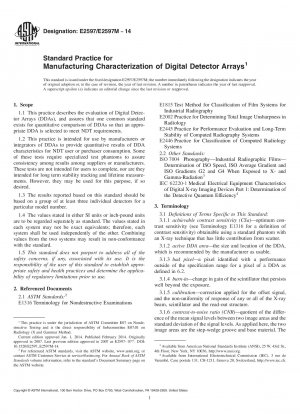ASTM E2597/E2597M-14
Standard Practice for Manufacturing Characterization of Digital Detector Arrays
- Standard No.
- ASTM E2597/E2597M-14
- Release Date
- 2014
- Published By
- American Society for Testing and Materials (ASTM)
- Status
- Replace By
- ASTM E2597/E2597M-22
- Latest
- ASTM E2597/E2597M-22
- Scope
4.1 This practice provides a means to compare DDAs on a common set of technical measurements, realizing that in practice, adjustments can be made to achieve similar results even with disparate DDAs, given geometric magnification, or other industrial radiologic settings that may compensate for one shortcoming of a device.
4.2 A user must understand the definitions and corresponding performance parameters used in this practice in order to make an informed decision on how a given DDA can be used in the target application.
4.3 The factors that will be evaluated for each DDA are: interpolated basic spatial resolution (iSRbdetector), efficiency (Detector SNR-normalized (dSNRn) at 1 mGy, for different energies and beam qualities), achievable contrast sensitivity (CSa), specific material thickness range (SMTR), image lag, burn-in, bad pixels and internal scatter radiation (ISR).
1.1 This practice describes the evaluation of Digital Detector Arrays (DDAs), and assures that one common standard exists for quantitative comparison of DDAs so that an appropriate DDA is selected to meet NDT requirements.
1.2 This practice is intended for use by manufacturers or integrators of DDAs to provide quantitative results of DDA characteristics for NDT user or purchaser consumption. Some of these tests require specialized test phantoms to assure consistency among results among suppliers or manufacturers. These tests are not intended for users to complete, nor are they intended for long term stability tracking and lifetime measurements. However, they may be used for this purpose, if so desired.
1.3 The results reported based on this standard should be based on a group of at least three individual detectors for a particular model number.
1.4 The values stated in either SI units or inch-pound units are to be regarded separately as standard. The values stated in each system may not be exact equivalents; therefore, each system shall be used independently of the other. Combining values from the two systems may result in non-conformance with the standard.
1.5 This standard does not purport to address all of the safety concerns, if any, associated with its use. It is the responsibility of the user of this standard to establish appropriate safety and health practices and determine the applicability of regulatory limitations prior to use.
ASTM E2597/E2597M-14 Referenced Document
- ASTM E1316 Standard Terminology for Nondestructive Examinations
- ASTM E1815 Standard Test Method for Classification of Film Systems for Industrial Radiography
- ASTM E2002 Standard Practice for Determining Total Image Unsharpness in Radiology
- ASTM E2445 Standard Practice for Qualification and Long-Term Stability of Computed Radiology Systems
- ASTM E2446 Standard Practice for Manufacturing Characterization of Computed Radiography Systems
- ISO 7004 Photography - Industrial radiographic films - Determination of ISO speed, ISO average gradient and ISO gradients G2 and 64 when exposed to X- and gamma-radiation
ASTM E2597/E2597M-14 history
- 2022 ASTM E2597/E2597M-22 Standard Practice for Manufacturing Characterization of Digital Detector Arrays
- 2014 ASTM E2597/E2597M-14 Standard Practice for Manufacturing Characterization of Digital Detector Arrays
- 2007 ASTM E2597-07e1 Standard Practice for Manufacturing Characterization of Digital Detector Arrays
- 2007 ASTM E2597-07 Standard Practice for Manufacturing Characterization of Digital Detector Arrays
